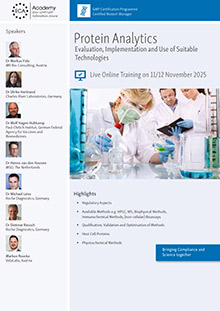Annex 15 and FDA Process Validation Guideline: Similarities/differences from the FDA perspective

Recommendation
5/6 February 2026
The "new" FDA Process Validation Guidance has been in force since January 2011. The revised Annex 15 has been valid since 1 October 2015. At a Conference in September 2015 which was co-sponsored by the FDA, Grace McNally, Senior FDA Official reported about similarities and differences between the two documents from the perspective of the FDA.
First to the similarities: both documents address a process validation life cycle and quality risk management across all stages of the life cycle. For Grace McNally there is also comparability with regard to a science-based process development and to the development of process understanding as the basis for stage 2 in accordance with the FDA Process Validation Guideline, resp. with the actual process validation in the sense of Annex 15. Prospective validation is favoured in both documents. Only in special cases one concurrent validation is possible, but is never favoured as a routine procedure. The FDA also sees similarities between the Annex 15 and the FDA Process Validation Guideline relative to the need for a rationale for determining the number of samples for PPQ/process validation, as well as in determining the number of PPQ - / validation runs. And this rationale should include, for example, the process variables and the complexity and experience with the process. For the FDA there are further similarities with regard to statistical methods and analyses as part of the process validation: mentioned are PAT, multivariate SPC, statistical methods regarding variability and process capabilities, trend analyses and methods for measuring/evaluating process stabilities and capabilities. Moreover, the authority considers stage 3 in the process validation life cycle (continued/ongoing process verification) as comparable. An exception is mentioned below in the differences. Finally, the requirements for change control in both FDA Process Validation Guideline and the revised Annex 15 are also similar from the perspective of the FDA.
But what are now the differences between the FDA Process Validation Guidelines and the revised Annex 15?
As one difference the Annex 15 asks to also list non-critical attributes and parameters in the validation protocol. The FDA Process Validation Guideline only requires the specification of critical quality attributes and critical process parameters. The FDA sees another difference in the number of validation batches. Annex 15 refers to the minimum number of 3, whereas the FDA Process Validation Guideline does not mention a number. For the FDA there is another difference in terms of process validation approaches. In Annex 15 three approaches are mentioned (traditional, continuous process verification, hybrid), while the FDA Process Validation Guideline makes no distinction. Further, the requirements for statistics also differ in the two documents. This topic is emphasized more in the FDA Process Validation Guideline. The FDA even recommends that a statistician should create the data collection plans and should also be consulted with regard to the use of statistical methods. This requirement goes beyond what is stated in the FDA Process Validation Guideline. It "just" recommends someone with statistical knowledge. The FDA also sees differences regarding the subject of sampling in the stage 3 of the process validation life cycle (continued/ongoing process verification). The FDA Guideline demands a higher number of samples (comparable to stage 2) - at least until sufficient data exist to assess variability. There is no such demand for an increased number of samples in the ongoing process verification in Annex 15. In addition, it addresses transport, packaging operations and cleaning validation, while the FDA Guideline addresses processes in general. Also, Annex 15 mentions more details with regard to transfer, bracketing and qualification. However, the FDA Process Validation Guideline does not address the qualification stages DQ IQ, OQ as such, but mentions similar requirements.
Conclusion
There is (gratifying) much conformity between the FDA Process Validation Guideline and the revised Annex 15. A better match with the FDA Guideline was also one of the reasons for the revision of Annex 15.
But there are also differences, and companies that want to operate both in the US market and in Europe have to be aware of these differences. The recommendation that a statistician should create the data collection plans and should be consulted with regard to the use of statistical methods is somewhat surprising. This requirement goes beyond what is stated in the FDA Process Validation Guideline. Here "just" someone with statistical knowledge is recommended. On the other hand this emphasizes the FDA's increased focus on statistics in the field of process validation. Information on knowledge of statistics cannot be found in Annex 15.





